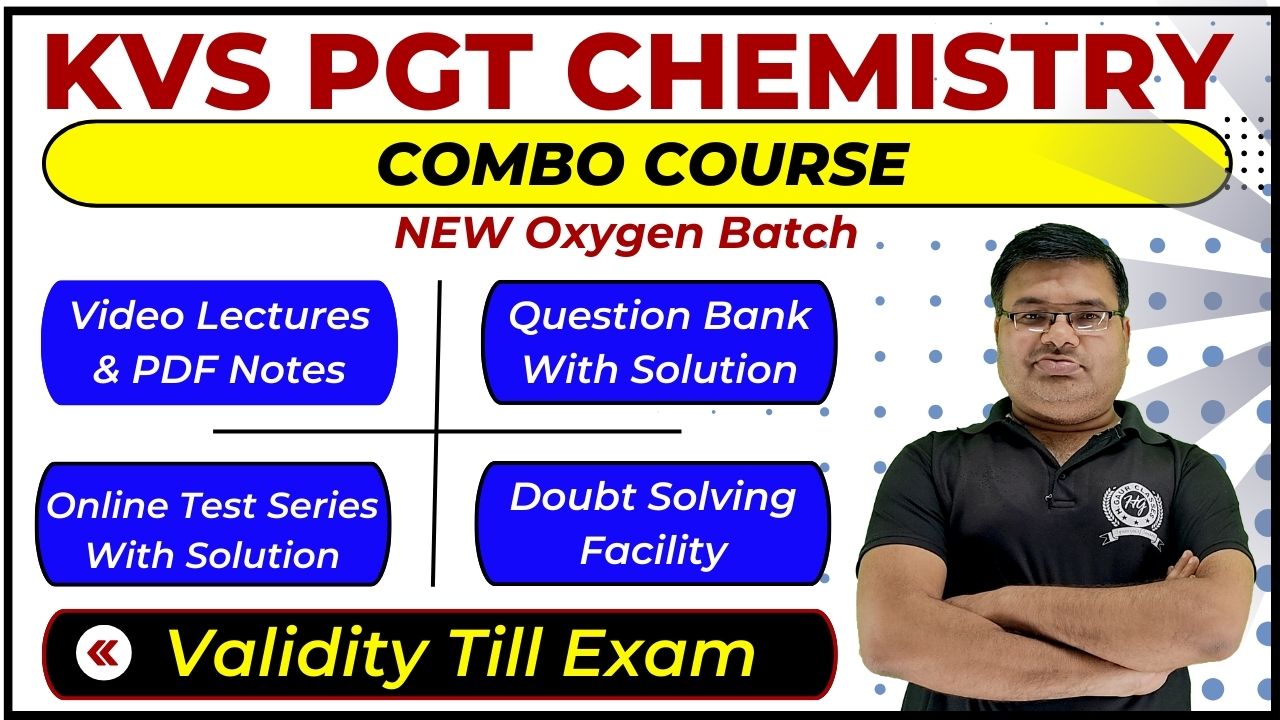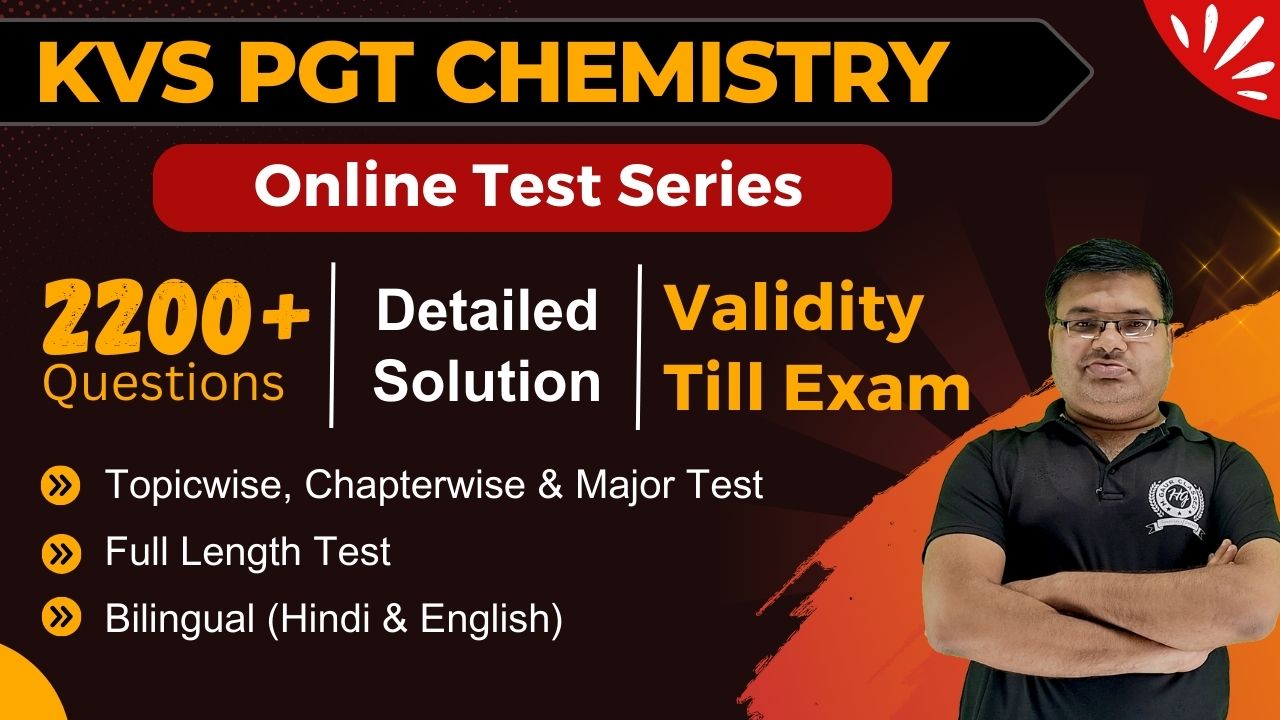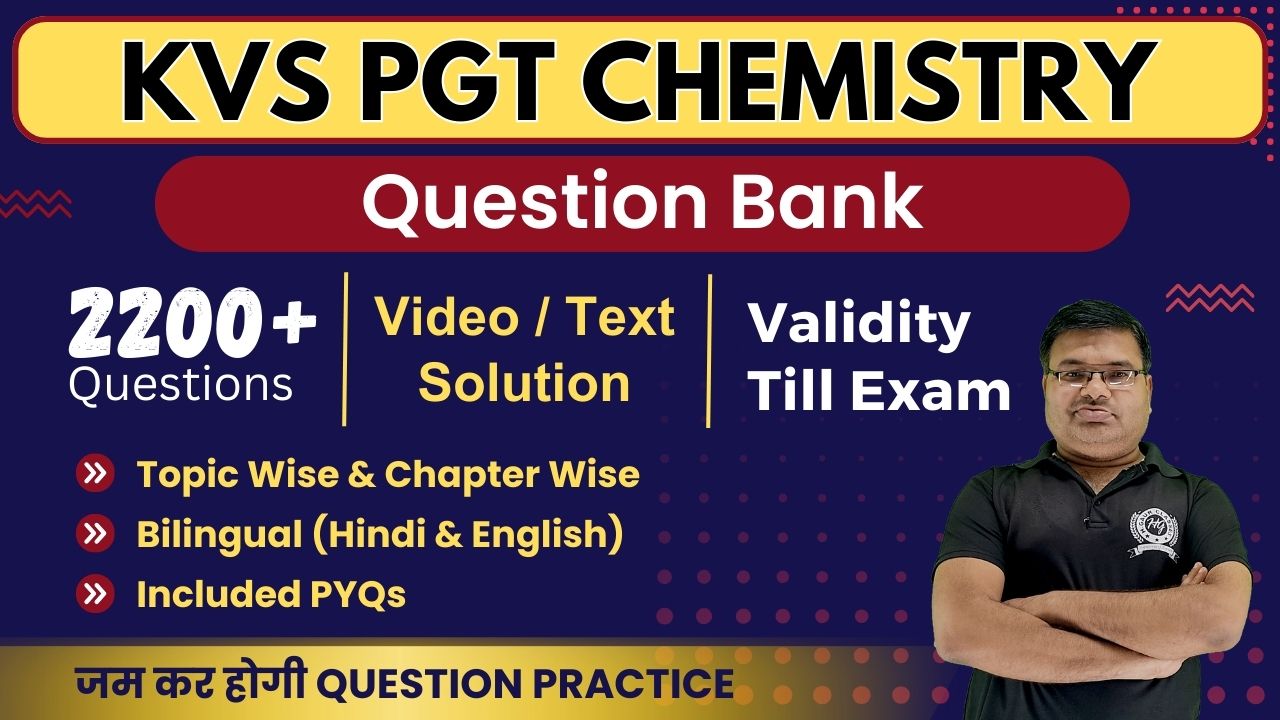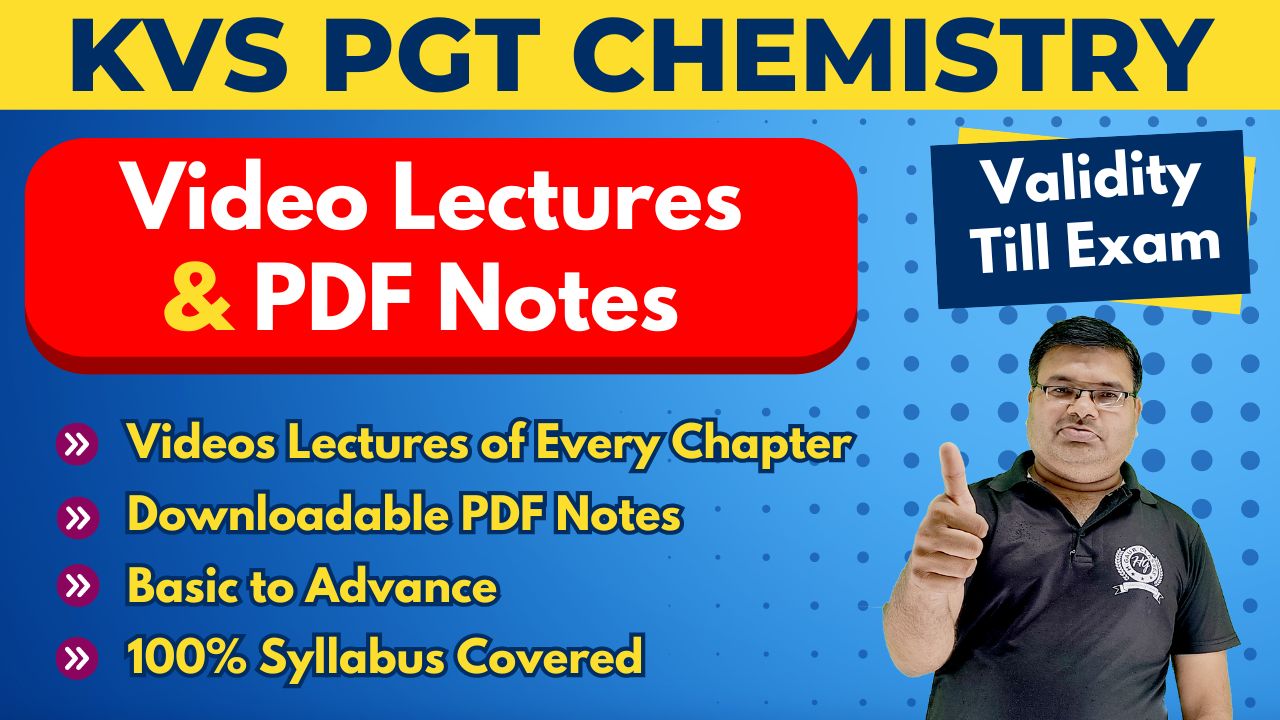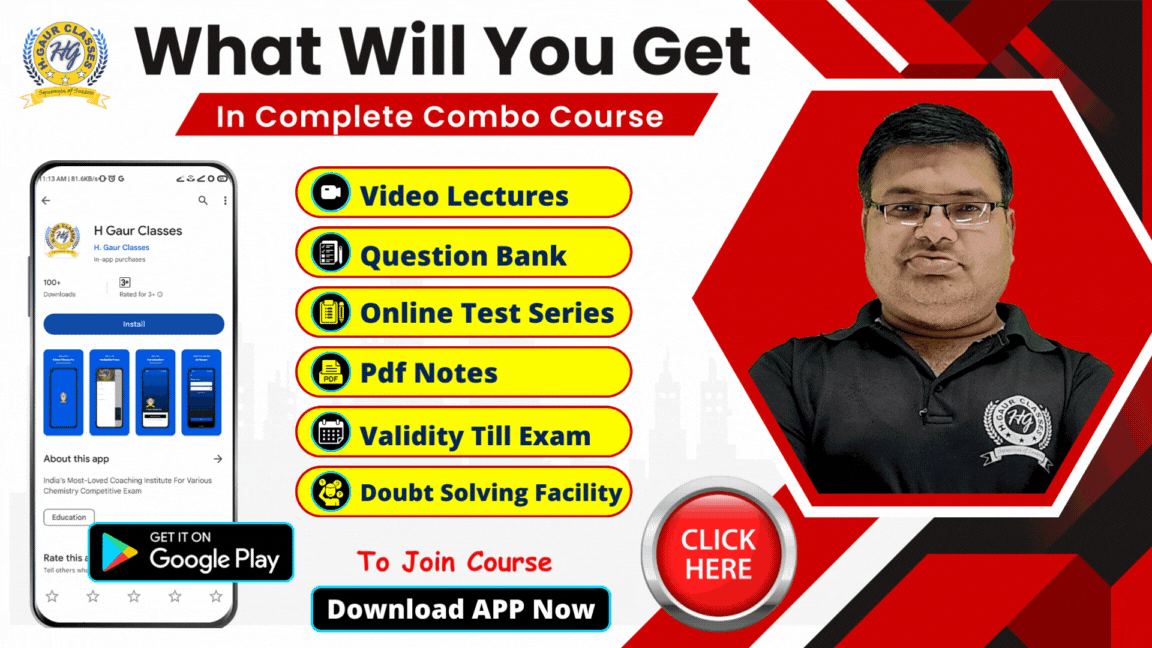Build Your Future As KVS PGT Chemistry Teacher
H. Gaur Classes Offer Online Courses for KVS PGT Chemistry for the aspirants who are willing build their career in teaching and work as government PGT Teacher at various School run by the Kendriya Vidyalaya Sangathan.
Under the extreme guidance of most experienced faculties, we guide students so that they can understand the exact scenario of exam and crack the exam easily. We have produced remarkable result in 1st Grade (PGT) exams and we are proud of our students.
We offer KVS PGT Chemistry Course so that students can prepare for the exam enrolling into single course and can easily get course at most affordable price.
Select a Course To Get Detail
Start Preparing For KVS PGT Chemistry
H Gaur Classes is offering Online Courses for KVS (PGT) Chemistry to help the students or aspirants to prepare for upcoming vacancies, so that they can start preparation on time. Admission for online New Batches is now open, and student can call us for more details. We assist the students to learn the concepts from basics to advance under the guidance for top experienced faculties.
Upper age limit
- Not exceeding 40 years
Essential Qualifications:
- Two Year Integrated Post Graduate Course from Regional College of Education of NCERT or any other NCTE recognized University / institute, in the concerned subject with at least 50% marks in aggregate.
- Note: B.Ed Degree is not required for the candidates who have undergone 04 years integrated degree course of Regional College of Education of NCERT or other NCTE recognized institution.
- Or Master Degree from a recognized university with at least 50% marks in aggregate in Chemistry/Bio Chemistry.
- Important Note: Candidates possessing Master’s Degree with specialization in discipline (s) / subject (s) as mentioned above will only be considered as eligible.
- B.Ed Degree.
- Proficiency in Teaching in Hindi and English medium.
Desirable Qualification
- Experience as TGT in the recognized institution in concerned subject.
- Experience of working in a residential school.
- Knowledge of Computer application.
Age Relaxation
Maximum relaxation in upper age limit will be as under:- Scheduled Caste / Scheduled Tribe - 5 years
- Other Backward Classes (Non-Creamy Layer) - 3 years
- Women (All Category) only if applying for PGTs, TGTs and Miscellaneous Category Teachers posts - 10 Years
- Regular NVS Employees - No age bar
- Candidates with 3 years continuous service in Central Govt. provided the posts are in same or allied cadres - 5 years
- Persons ordinarily domiciled in State of Jammu & Kashmir during 01.01.1980 to 31.12.1989
- Persons with disabilities (i) SC/ST (15 years) (ii) OBC (NCL) (10 years) (iii) General (10 years) For woman with disability, clause (3) is not applicable.
- Ex-Servicemen who has put in not less than six months continuous service in Armed Forces (Army, Navy and Air Force) shall be allowed to deduct the period of such service from his/her actual age and if the resultant age does not exceed maximum age limit prescribed for the post by more than three years, he / she shall be deemed to satisfy the condition regarding age limit. (Important: Such exserviceman who are already employed as regular civil employees under Government by availing benefit of reservation as ex-serviceman are entitled for age relaxation only as provided under extant rules).
Mode of Selection
Candidates will be selected on the basis of their performance in written examination and interview put together. KVS reserves the right to decide the cut Off marks in written examination and interview separately. The decision of KVS about the mode of selection to the above posts and eligibility conditions of the applicants for interview shall be final and binding. NO correspondence will be entertained in this regard.
However, the mode of selection for all the above posts will be at the sole discretion of Kendriya Vidyalaya Sangathan and may be changed before the date of start of the online application with due notification. The final merit list of PGTs will be based on the performance of the candidates in written test, interview and performance test (where applicable). The weightage of written test and interview will be 85: 15 for the post of PGT Teacher.
Scheme of Examination
- Test Duration: 150 minutes
- Total Questions: 150 Objective type multiple choice questions
- Total Marks: 150 Marks
| Section Name (Nature of Questions) | Marks per item | Number of Items |
| Part I: 1) General English 2) General Hindi | 1 marks per question | 10 questions English, 10 questions Hindi |
Part II:
|
1 marks per question | No. of questions in each part
|
Interview: 60 Marks
Note: The final merit list will be based on the performance of the candidates in Written Test and Interview. The weightage of Written Test and Interview will be 85:15.
- Some Basic concepts of Chemistry: Scope of chemistryHistorical approach to nature of matter - states of matter, properties of matter and its measurement, S. I system of units, Uncertainty in measurements, dimensional analysis, Laws of chemical combination, atomic and molecular masses, Mole concept and molar masses, percentage composition, empirical and molecular masses, equivalent weight, concept of limiting reagent
- States of Matter: Gases, liquids and solids, three states of matter, types of intermolecular forces. The laws governing ideal gas behaviour, Dalton’s law of partial pressure, Kinetic molecular theory of ideal gases, Maxwell Boltzmann distribution law on molecular motion, real gases – deviation from ideal behaviour, vander Waals equation. Liquid and their properties. Solids: Classification of solids, fundamental types of lattices, two and three dimensional lattice types, Simple crystal structures, Transformation of crystal structure on varying temperature, Bragg’s law, density in solids, energy band, band gaps, semiconductors, magnetic and dielectric properties, stoichiometric and non- stoichiometric defects in solids.
- Structure of Atom:Structure of Atom (Classical Theory), Dalton’s atomic theory, Bohr’s model of atom, Structure of atom (modern theory), de Broglie’s relationship, Heisenberg’s uncertainty principal, Classical wave equation, Schrödinger’s wave equation, Probability distribution curve, Quantum numbers, Pauli’s exclusion principle, Aufbau principle, Hund’s rule of maximum multiplicity.
- Equilibrium: Reversible reactions, criteria of equilibrium, Law of mass action, equilibrium constant, Kc and Kp , Le Chatelier principle, Ionic equilibrium, Ostwald’s dilution Law, solution of acids, bases, ionic equilibria in solution, Common ion effect – its application to qualitative analysis, acids and bases, Bronsted- Lowry theory of acids and bases, Lewis concept of acid and bases, relative strengths of acids and bases, their quantitative estimation, buffer solution and its use, determination of pH, theories of indicators, conductometric titration, Solubility product, hydrolysis.
- Surface Chemistry:Adsorption, absorption, sorption, Physical adsorption, Chemisorption adsorption, isotherms ( Freundlich, Langmuir), application of adsorption, types of Catalysis theories of catalysis, classification of colloids, preparation of Colloidal Solution (lyophobic and lyophilic), Special characteristics of colloidal solutions , electrophoresis, Precipitation of colloids – Hardy Schulze law, multimolecular and macromolecular colloids, Emulsion and Gels.
- Chemical Kinetics: Theories of reaction rates, rate of reaction , molecularity and order of reaction, Fast reactions- Luminescence and energy transfer process, reaction mechanisms(Simple and complex reactions).
- Redox Reaction and Electrochemistry: Oxidation and reduction, redox reaction and its application, oxidation number, Strong and weak electrolytes, activity coefficient, conductance and conductivity, Kohlrausch law, resistance and resistivity molar conductivity, equivalent conductivity, Qualitative and quantitative aspect of electrolysis, electrochemical cell and electrolytic cell, Electrode and electrode potential and standard electrode potential, Electrochemical series and its applications, Nernst equation and its application, Equilibrium constant and EMF of the cell.
- Solutions:Solution and its types, expression of concentration of solution, solubility and factors affecting the solubility of a solid in a liquid (temperature and pressure), Vapour pressure of a liquid, Raoult’s law for both volatile and non volatile solute,Ideal and non ideal solution, Colligative properties, abnormal molecular masses and Van’t Hoff factor.
- Chemical bonding and Molecular Structure: Valence electrons and Lewis structures, Ionic bond, Covalent bond, Bond parameters ,Co-ordinate bond, polarity and dipole moment, Quantitative idea of – valence bond theory, molecular orbital theory (LCAO), Concept of hybridization involving s, p, d orbitals, Hydrogen bond, Resonance.
- Thermodynamics:Macroscopic properties of the system, modes of transfer of energy between system and surrounding, Phase transition, phase rule and phase diagram, First Law, second law and third law, of thermodynamics. Internal energy and enthalpy of the reaction, their measurement and application, spontaneity of process, Entropy and spontaneity, Helmholtz and Gibb’s free energy, Thermodynamics of electrochemical cells.
- Classification of elements and periodicity in properties: Significance of classification, brief history of the development of periodic table, periodic laws, name of the elements with Z>100 according to IUPAC system, classification of elements into s, p, d, f –block elements and their characteristics, Periodic trends in the properties of elements – Ionization enthalpy, Electron gain enthalpy, electronegativity, atomic radii, ionic radii, periodicity of valency or oxidation state.
- Hydrogen: Position of Hydrogen in periodic table, occurrence, isotopes, Preparation of hydrogen, on small and commercial scale, hydrides, water, hard and soft water, heavy water, hydrogen peroxide, hydrogen economy, hydrogen as a fuel.
- General principles and processes of isolation of elements and s – block elements: Principles and methods of extraction, oxidation and reduction as applied to the extraction procedures of Al, Cu, Zn and Fe. s – block elements, general introduction – Electronic configuration, occurrence, Anomalous properties of the first element of each group, diagonal relationship, Trends in variation of the properties, reaction of alkali and alkaline earth metals. Preparation and properties and uses of some important compounds: - sodium carbonate, sodium bicarbonate, sodium chloride, sodium hydroxide, calcium hydroxide and calcium carbonate, industrial uses of lime and lime stone, biological importance of sodium, potassium, magnesium and calcium.
- p – Block Elements: Electronic configuration, variation in physical and chemical properties of groups 13 to 18, physical and chemical properties of borax, boric acid, boron hydride, silicones, preparation and uses, preparation, properties and uses of nitrogen, ammonia, nitric acid and oxides of nitrogen, phosphorus – allotropic forms, preparation and properties of phosphine, phosphorus pentachloride and phosphorus trichloride, preparation, properties and uses of oxygen and ozone, hydrides and halides of 16 group elements, their structure and nature, allotropic forms of sulphur- their preparation, preparation, properties and uses of sulphur dioxide, industrial preparation of oxo-acids of sulphur, preparation and properties of halogen and halogen acids, inter halogen compounds, pseudohalide ions. Oxo-acids of halogens, their structure and nature, preparation, properties and uses of xenon fluorides, oxides of xenon and xenon oxo fluorides.
- The d – and f- Block Elements: General introduction, electronic configuration and general trend in the properties of first row transition metals like metallic character, ionization enthalpy, oxidation states, ionic radii, coloured ion formation, catalytic properties, magnetic properties, oxides, halides and sulphides of first row transition metals, complex compound formation etc. Preparation, properties and structures of KMnO4 and K2Cr2 O7, lanthanoids and actinoids.
- Co-ordination Compounds and organometallics: Meaning of co-ordination compounds, Werner’s theory, ligands – their types, IUPAC nomenclature of co- ordination compounds, isomerism, bonding in co-ordination compounds, colour, magnetic properties and, stabilities of co-ordination compounds. Chemical and biological importance of coordination compounds, metal carbonyls: preparation, properties and bonding, organometallic compounds and their classification.
- Organic Chemistry : Some Basic Principles and Techniques: General Classification of organic compounds, Shapes of organic compounds-Hybridisation(sp, sp2,sp3), Structural representation of organic molecules, Functional groups, Homologous, series. Common or trivial names, nomenclature of aliphatic, aromatic and substituted aromatic compounds. Isomerism : Structural and Stereo isomerism Fundamental Concepts in Reaction Mechanism: Cleavage of covalent bond, Types of attacking species, electron movement in organic reactions, electronic displacement in a covalent bond and types of organic reactions. Methods of purification of organic compounds: Qualitative analysis, Quantitative analysis., estimation of the elements and determination of empirical and molecular formula.
- Hydrocarbons: Classification of hydrocarbons. Alkanes: Conformations (Newmann and Sawhorse formulae), Physical properties, Chemical reactions Cycloalkanes: Preparation, physical and chemical properties, stability of cycloalkanes(Bayer strain theory), chair and boat forms of cyclohexane. Alkenes: structure of double bond, geometrical isomerism, physical properties, methods of preparation, chemical reactions. Alkadienes: Classification of dienes, Preparation of conjugated dienes, Chemical properties(1,2 and 1,4- addition to conjugated dienes). Alkynes: structure of triple bond, physical properties, methods of preparation Chemical properties, Acidic nature of alkynes Aromatic Hydrocarbons: Structure of benzene, resonance, aromaticity (Huckel’s rule) Chemical properties, mechanism of electrophilic substitution direct influence of substituents in monosubustituted benzene.
- Environmental Chemistry: Environmental pollution, Atmospheric pollution, Tropospheric pollution(Air pollution), Major air pollutants, Control of air pollution, Smog(Chemical and Photochemical smog), Stratospheric pollution: Ozone layer and its depletion, Acid rain, Green House Effect and Global warming, Water pollution, Soil pollution and Industrial waste.
- Haloalkanes and Haloarenes: Classification, methods of preparation of haloalkanes and haloarenes, their physical properties, tests to distinguish between alkyl and aryl halides, mechanism of SN1 and SN2 reactions, elimination reactions (Saytzeff Rule, E1 & E2 mechanism).Poly halogen compounds: Preparation and properties.
- Alcohols, Phenols and Ethers: Classification, preparation, properties and uses, tests to distinguish between primary, secondary and tertiary alcohols. Distinctions between alcohols and phenols. Preparation of ethers , physical and chemical properties.
- Aldehydes, Ketones and Carboxylic Acids: Structure of carbonyl group, preparation of aldehydes and ketones, physical , Chemical properties and uses, tests to distinguish between aldehydes and ketones .Preparations of carboxylic acids preparation properties and uses.
- Amines (Organic compounds containing nitrogen ): Classification, Structure of amino group, preparation, Physical, Chemical properties, tests to distinguish between primary, secondary and tertiary amines
- Polymers: Polymerization, Classification of polymers based on : origin, structure, molecular forces, mode of polymerization. Addition polymerization Condensation polymerization(Step-growth polymerization) Preparation of condensation polymers Synthetic and natural rubber and vulcanization, Determination of molecular mass of polymers:. Poly dispersity index(PDI). Bio-degradable polymers like PHBV.
- Biomolecules(Biochemistry):Carbohydrates: Classification of carbohydrates , Structural determination of glucose and fructose on the basis of their chemical properties, Open chain (Fischer) structure, cyclic structure(Haworth form), alpha and beta forms of glucose, Mutarotation, anomers and epimers, Chemical reactions of glucose, Reducing and non-reducing sugars, Configuration of glucose and fructose. Disaccharides Sucrose, Haworth representation of disaccharides, Polysaccharides, Starch, Cellulose, and amylopectin structures, Functions of Carbohydrates in living organisms. Carbohydrate metabolism, glycolysis, electron-transport chain, Proteins: Amino acids, Zwitter ion, Iso-electric point, peptides and peptide bond, Fibrous proteins, Globular proteins and their functions, Primary, Secondary(Helix and pleated sheet structures) and tertiary structure of proteins, denaturation and renaturation, Enzymes, specificity and mechanism of enzyme activity , coenzymes, applications of enzymes. Nucleic acids : Nucleosides, Nucleotides, Structure of ATP, Photosynthesis(Light and dark reactions) Primary and Secondary structure of DNA(Double Helix structure) , biological functions of nucleic acids, Replication, Protein synthesis (Transcription, Translation, mutation), genetic code, genetic errors, Vitamins, classification, diseases caused by the deficiency of vitamins, Hormones (steroid hormones and non-steroid hormones) and their functions.
- Chemistry in Everyday life: Drugs and medicines - designing a drug, drug metabolism, classification of drugs, enzymes as drug targets, action of drug through drug receptor interaction, types of drugs: Antipyretics, Analgesics, antiseptics, disinfectants, tranquilizers, antimicrobials, antibiotics(Narrow spectrum and broad spectrum antibiotics), antifertility drugs, antihistmmines, antacids. Chemicals in food, Food preservatives, artificial sweetening agents, Soaps and detergents, Preparation soaps(Saponification) and detergents, cleansing action of soaps, advantages of detergents over soaps, Deodorants, Edible colours, antioxidants.
| S.No. | Topic Name | Watch Videos |
| 1 | Atomic Structure | Click To Watch |
| 2 | Solutions | Click To Watch |
| 3 | Chemical Kinetics | Click To Watch |
| 4 | Electrochemistry | Click To Watch |
| 5 | Thermodynamics | Click To Watch |
| 6 | Surface Chemistry (PGT) | Click To Watch |
| 7 | Periodic Table | Click To Watch |
| 8 | Coordination Chemistry (PGT) | Click To Watch |
| 9 | General Organic Chemistry (PGT) | Click To Watch |
| 10 | Isomerism | Click To Watch |

